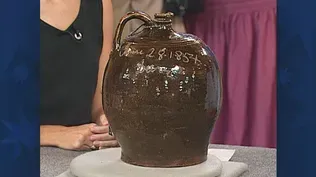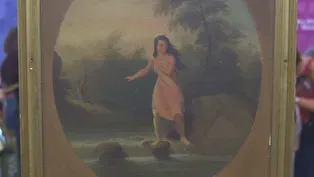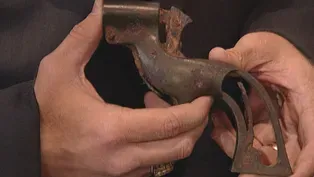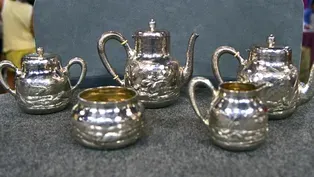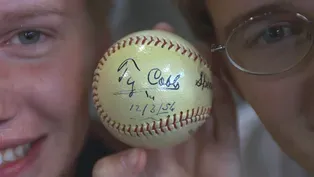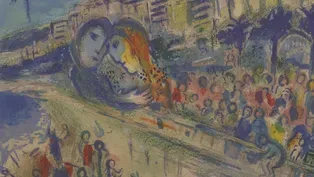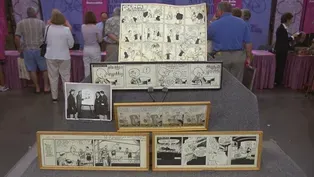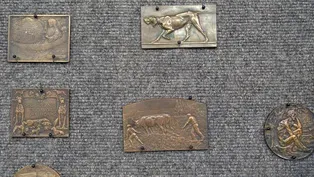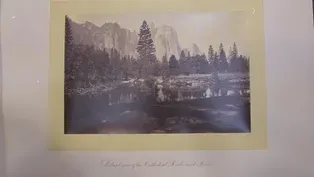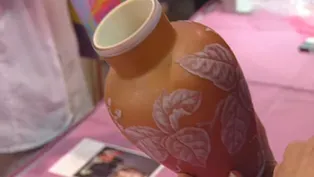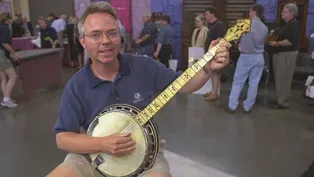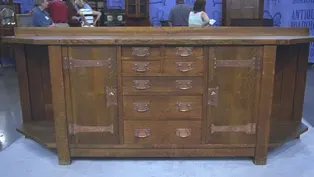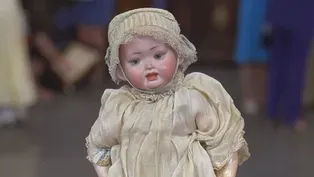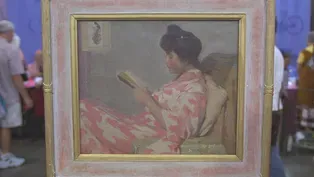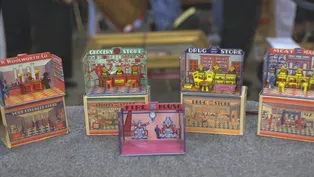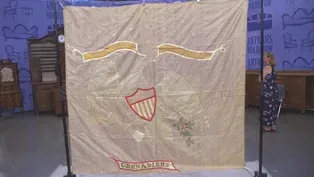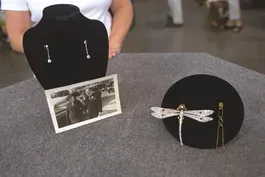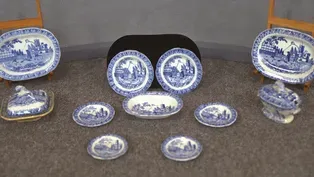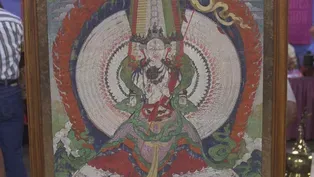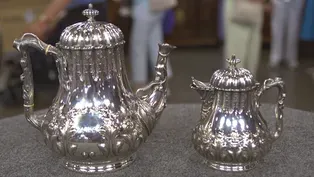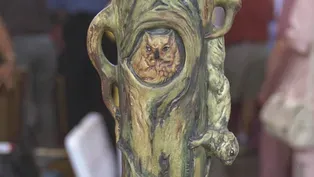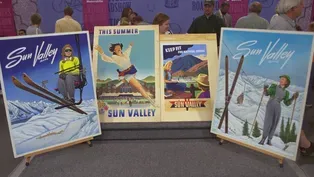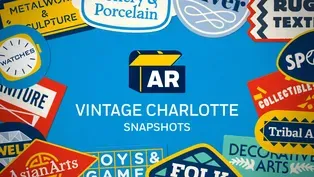

Vintage Charlotte
Season 21 Episode 25 | 52m 32sVideo has Closed Captions
Journey to 2002 to learn how past appraisals fare in today’s market!
Journey back to 2002 to learn how past appraisals fare in today’s market, including Spanish earrings and a dragonfly brooch, a Carleton Watkins Yosemite album, and an 1840 Alfred J. Miller painting. Can you guess which is valued at $75,000-$125,000?
Problems with Closed Captions? Closed Captioning Feedback
Problems with Closed Captions? Closed Captioning Feedback
Funding for ANTIQUES ROADSHOW is provided by Ancestry and American Cruise Lines. Additional funding is provided by public television viewers.

Vintage Charlotte
Season 21 Episode 25 | 52m 32sVideo has Closed Captions
Journey back to 2002 to learn how past appraisals fare in today’s market, including Spanish earrings and a dragonfly brooch, a Carleton Watkins Yosemite album, and an 1840 Alfred J. Miller painting. Can you guess which is valued at $75,000-$125,000?
Problems with Closed Captions? Closed Captioning Feedback
How to Watch Antiques Roadshow
Antiques Roadshow is available to stream on pbs.org and the free PBS App, available on iPhone, Apple TV, Android TV, Android smartphones, Amazon Fire TV, Amazon Fire Tablet, Roku, Samsung Smart TV, and Vizio.

ANTIQUES ROADSHOW 2025 Tour!
Enter now for a chance to win free tickets to ANTIQUES ROADSHOW's 2025 Tour! Plus, see which cities we're headed to!Providing Support for PBS.org
Learn Moreabout PBS online sponsorshipYou know the old adage, "Two heads are better than one"?
With this doll, it's like two faces are better than one.
Switch her around from the unhappy to the happy side.
Wow.
My goodness.
Can I give you a hug?
You can give me a hug.
MARK WALBERG: When Roadshow visited Charlotte in 2002, we saw this piece made by Gustav Stickley, the leader of the American Craftsman movement.
Because of changing tastes, the market for most Arts and Crafts furniture soon began to soften.
But how have prices fared for these high-end items?
We'll find out later in the show, but first, let's take a look at this print that may or not have been made by Marc Chagall.
APPRAISER: It is and it's not by Chagall.
And you're probably wondering how that can be at the same time.
(laughs) I wonder.
First of all, you can see that it's signed down here, and that is Chagall's signature, in pencil, okay?
And what happened is, Chagall made a watercolor, of this subject, which was then copied in a color lithograph by this fellow down here, Charles Sorlier.
Yeah.
So the actual printmaker of this image, who made this, is a fellow named Charles Sorlier, after a design by Marc Chagall.
Chagall would have worked with the printmaker, Sorlier, to produce the print, authorizing the colors, as he intended it to look, and then when he was done with it, working with Sorlier, and approved the image, he would sign it.
And it was issued in an edition, as you see down here, of 150.
Yours is pencil number 22 of 150.
So it's an original color lithograph that Chagall worked on, but he didn't actually make.
I see.
Okay?
My goodness.
Now, he made a series of 12 of these.
This is one of 12 that he made.
It's from a series called "Nice and the Cote D'Azur," All scenes illustrating the Bay of Angels in Nice.
And you see there's some actual images of Nice here, and then Chagall's signature fanciful images here of carts being pulled by horses with flowers and two lovers down here.
Chagall produced by himself, from his own hand, hundreds of prints.
He was a printmaker as well as a painter.
And one of the reasons why he worked with Sorlier to make a series like this of prints after his watercolors was to sort of extend his output.
He could produce more prints and have more of a commercial output.
My goodness.
The entire series of 12 lithographs was produced in 1967.
Now, you said you bought this at an antique store?
Yes.
And you spent several hundred dollars?
Yes.
Okay.
Each print from the series now sells for about $10,000 to $15,000.
Wow.
So your $300 investment has appreciated quite a bit.
You did very well buying that.
My God, I'm glad I did.
Yeah.
Well, it's been in my husband's family for a number of years.
His great-grandfather was a captain in the Civil War.
And we've had it since 1969 when his grandfather died and he found it in one of his closets.
And it's always been in your family, is that right?
Correct.
Well, let me tell you, this dates about 1820.
It's a militia flag.
It has 13 stars, it has "Death Before Dishonor," it has this wonderful eagle.
This eagle and this design is strictly the early part of the 19th century.
It is not the Civil War period that you thought about.
It's definitely an early eagle and an early style flag, and the way it's attached to the pole and the form of the eagle, and just the layout of the flag, it's an early militia flag.
It's faded, but it's survived in great condition.
And do you have any idea of the value?
No, I really don't.
Well, if I said $75,000 to $85,000, would you be surprised?
You're kidding!
No, I'm not.
It is wonderful.
You are kidding.
No, I'm not.
Oh, you're kidding.
No, I'm not.
And I've had it folded up in a paper bag.
Don't do that again.
Don't fold it, and take it to a textile conservator and have them take care of it for you.
It really deserves a lot of care, and it's something that you should do.
Keep it out of the sun.
Okay.
It's faded pretty much now, it's been in the sun.
Oh, goodness.
I can't believe it!
But it's just great, I'm so glad you brought it.
Oh, thank you!
I almost... can I give you a hug?
You can give me a hug.
Thanks a lot!
They went out of fashion in the late 1830s.
The ones from the 18th century are huge.
They're usually 50% bigger than this.
I would date this one to the later period, about 1820.
Where did you get this?
This is an interesting piece.
I found it in the trash.
In the trash?
In the trash.
If this was to come up at auction today, I would expect to put a price tag on it at about $2,500.
Not bad for the trash.
No, it isn't.
No, it isn't.
I'd like to find that in the trash.
That's free money!
My mother gave it to my sister when she was a young hippie, about 30 years ago, and she was going to California and I said, "Please let me keep that so you won't pawn it."
What's interesting about this watch is the fact that it's a fake.
Yeah.
But not the kind of fake you think it is.
It's about a 140-year-old fake.
It's actually Viennese, but it's trying to... and it was made about 1860, but it's actually trying to be a watch that was made about 1560.
Okay.
I found it at a yard sale.
But then you saw the show.
I saw your show and I said, "I think I have a pot that's signed, and I'll go see whose name's on it."
And when I looked, the hair just stood up on my neck, because it was the same, and I was really excited about it.
Well, this is a pot by Dave, who is known as "Dave the Slave," an Edgefield potter.
And interestingly enough, right here on your piece, it says "Mr. L.
Miles."
And then it says "Dave."
And Mr. L. Miles stands for Mr. Louis Miles, who owned Dave at that time, and in South Carolina, but the other thing that's very interesting is around here on this side, you have the date, and I believe it says April 27, 1840.
That's a very early date for Dave.
Is it?
Yeah.
He was a big man, and he had big hands and he could pot big pots like this one.
Anyway... Is this one of the bigger ones?
Well, not really.
Or is this a smaller one?
He made them big enough you could put a kid in one, but, uh, this one has some damages.
The handle blew off.
Now, that blew off in the making.
In the kiln.
I wondered about that.
And then here, there's, right under the name, there's a hole.
The prices on this kind of pottery, on Dave's pieces, have just escalated like mad.
If this was in perfect condition, it's a very important piece, it would be probably something like, uh, oh, I'd say $25,000 to $30,000.
Wow.
But as this is, in this condition, I think it's probably more like $15,000 to $20,000.
But even in this condition, it's worth that much money.
$20,000?
That's right.
$15,000 to $20,000.
$20,000?
Yeah, how about that?
Okay.
I can not believe this.
I can not believe this.
Right, well, I've handled an awful lot of Dave pottery and this is a wonderful piece.
We inherited this album through my mother-in-law's mother's estate, and we found it in the attic of the house that we inherited.
Well, what we have here is a period Morocco binding from the 1860s that is simply spectacular and that sets the stage for the contents of the album.
This is the title page of the album, basically indicating that the photographs were taken by America's premier landscape photographer of the 19th century, Carleton Watkins.
And if we look at some of these photographs, we can see why Watkins was considered a master of the photographic medium.
There's a kind of clarity, an inherent beauty to the pictures that transcends photography as a documentary form, and that in fact shows photography as a fine art, aesthetic form.
Watkins would take a camera into the landscape that used glass plate negatives, coat these glass plate negatives on-site, take his picture, remove them, take them to a processing tent.
Photography was a little different back then in terms of the hands-on labor, the craft and technique.
In terms of the quality of the photographs, these are basically, on a scale of one to ten, a ten.
They're as good as it gets.
These are albumen prints.
They have a nice rich, brown, kind of eggplant tone.
And what I love about the album is that the selection of photographs is unique to this album.
I counted 50 and it's fairly certain that this is the only album of its kind with this particular selection and number of images.
Based on the fact that this is a presentation album, with 50 original photographs, I would say that an auction estimate for the album would be in the $70,000 to $100,000 price range.
Wow.
My goodness.
That's wonderful!
WOMAN: Well, this is a very special collection that was given to me by my uncle, who purchased this in New York in 1971.
I guess he purchased it when I was about 11 years old.
And for every birthday, he gave me a couple pieces.
And, at the time, you know, not, I guess, real excited about it until I got older and started appreciating it more.
But he basically gave me 44 pieces, I guess, in the collection.
You know it's English, it's Staffordshire.
It's early 19th century, so we can date it to about sort of 1820 to 1830.
Now, that is significant in the fact that it is a child's set and one would think that children's sets don't usually survive that long.
It is rare to find a child's set of this early date.
We find dinner services because grown-ups take care of things, but children play with these, so I think that's what makes it special.
I think the other thing that makes it special is the decoration of the pieces.
Two boys playing with a kite and a hoop-- very charming.
A children's scene on a children's set, always love that.
And I think also significant is in the center you have a gravestone.
And I think that is to signify how many children really died in the 19th century.
Wow.
The other thing is, it's a very sophisticated set.
This shape of the terrine is based on a Chinese export.
You have 44 pieces, which is quite a large set, and you have serving pieces, which are important, in a child's set as well as in a grown-up set, in an adult dinner service, which would look very much the same.
I would think very easily at auction for a set like this, you're looking at $3,000 to $5,000.
And if you're thinking of an insurance value for it, you would have to probably double that value.
Wow, thank you, I appreciate it.
Thank you.
WOMAN: After my mother died and my father sold the house, we went into the attic and there was a box of dolls.
And I never knew anything about them.
Been in there for at least 40 years.
And I pulled this one out because I thought she was interesting.
You know the old adage, "Two heads are better than one"?
With this doll, it's like two faces are better than one.
Switch her around from the unhappy to the happy side and...
This is a character doll, which was made in Germany, early part of this century, maybe 1905, 1910.
It's a baby doll, which is a doll that children actually did play with.
It's not just a little art form, it's a child's toy.
And character dolls are very popular at that time.
They went out of favor probably in the early 1920s.
Nice original clothes, there's glass eyes on the one side, and there were painted eyes on the other side.
It was produced by a company called Hertel and Schwab and Company in Germany in a place called Ohrdruf, Germany.
And they were a company that had a porcelain factory where they made dolls for other people.
This was probably made for a company called Kley & Hahn.
So, great character doll, good condition.
Think it's worth anything at all?
Oh, a little, but I don't know how much.
Oh, probably like, maybe $3,000 to $4,000.
Wow, that's great.
You've got a great little two-faced kid.
Thank you.
I'm going to put her back to the sad side.
Oh.
(laughs) WOMAN: My father was a train buff, but he was actually an Army officer.
Right.
And on his way to the Korean War he stopped at the Southern Railway office, where he was friends with the executive vice president.
And he asked for a memento of the railroads, and my father went on to the war, and the Railway Express brought the bell to my mother.
I would estimate this in the $3,000 price range.
Wow.
(bell ringing) This is a very beautiful French bodice from about 1770.
APPRAISER: If you look very closely at the glass itself, you can see that it has an iridescence with what they sometimes call oil spot decoration.
WOMAN: Okay.
Which is very characteristic of the Loetz Glass Company in Austria.
Oh!
So very collectible glass.
The vase itself would be worth $1,500.
And the silver, we're talking about twice as much.
My mother purchased it in 1963 from a gentleman who had a side business, but sold a few antiques.
And she paid $40 for it.
$40 for it, yeah.
Oh, the frame, she was told by the man she bought it from, was made by Native American Indians.
That's all we know.
So that's all we know about it, that's what she was told.
Yeah.
Well, the picture is signed and dated down here.
The artist's name is Dawson Dawson-Watson.
His first name, and the first part of his second name, were the same-- Dawson-- and then Dawson-Watson, a hyphenated name.
And it's dated 1914.
He was born in London, and he studied in Paris.
And for about five years, he lived very close to Claude Monet, the French Impressionist.
Then he moved to the United States, and he's actually famous as a painter of cacti.
Here we see a classic haystack landscape, very much influenced by someone like Monet.
I'm not so sure that this is a Native American frame.
I think in 1914, it could very easily be what you call Arts and Crafts.
It's the original frame, and it's a great frame.
But I think your mother made a great investment, because I think it's worth about $10,000 to $15,000.
(laughing): Oh, my gosh.
We were... We were joking about it because we didn't want to bring it.
We thought it might be $50.
But thank you so much.
(laughing): That is exciting.
Thanks for coming to the Roadshow.
Oh, my goodness.
Well, my father was a cartoonist.
He started drawing in the 1930s.
In the old days, cartoonists used to travel together going to shows to do chalk talks where they would draw and talk to the audience and entertain.
And the cartoonists got to know each other, so they would swap originals.
So I was a little boy, I was about four or five years old, and every so often a new cartoon would come in.
And there's nothing cooler than cartoons to a little kid.
And it would come in and get framed and put on the wall in our basement.
So I've had these with me all my life.
Well, what we have here is just a great example of 20th century pop culture.
I mean they're just the essence of what cartoons are.
And I love it because it really starts from the '30s and goes on.
And cartoons nowadays are popular on animation and on television and multimedia.
But where it really all started was here.
We start here, what I was impressed with, the Dick Tracy.
Both of these pieces right here are dailies.
They were used for a daily comic strip in a magazine or a newspaper.
And they're original artwork, and it is signed actually, by Gould, which makes this even more valuable, the fact that the artist signed it.
Over here what we have is Joe Palooka, which a lot of people don't know who it was, but this cartoon came out in the 1930s and became one of the most famous sports cartoons.
So for people that collect sporting art, this actually is very, very collectible.
And then right here we go back and we have Blondie.
Now, some people these days don't really know Blondie, but in the '30s and the '40s it was very, very, very popular.
And actually, Chic Young won an award for being the National Cartoon Artist at the time.
I may have been at that award.
Oh, really, at the ceremony?
Because my father used to take me to the National Cartoonists Society meetings.
Yeah.
And these people would be there.
And I would always get dragged along, just... awed, all these wonderful people.
Well, it's like the Academy Awards for cartoonists.
Yes.
And then I thought this was interesting up here because you have Popeye, but it's much later on.
It's in the '60s.
And a lot of these are much earlier.
So it's collectible.
It's not as collectible as the ones from earlier years.
And what's happened now is Popeye's kind of not as popular because he was beating people up.
(laughs) Now here we go, the crème de la crème is this piece.
1950s when Schulz started, this is 1951.
It's so early, it's so beautiful.
And this piece alone, I saw you in line and I just got so excited because it's so rare.
It's just one of a kind, it's a great piece.
This piece alone is worth $8,000 to $10,000.
And I would say your whole collection together is worth about $10,000 to $15,000.
You're kidding.
No, I'm not.
(laughing): Oh, my goodness.
My wife wins.
It's a wonderful piece.
My wife and I had a bet going.
We didn't have exact numbers, but she definitely wins.
(laughing) Yeah, it's a wonderful collection.
Oh, it's marvelous.
Thank you for sharing with us.
Oh, thank you.
My grandmother wanted to give me an heirloom as a wedding present, and this had belonged to my great-great-grandmother.
She had gotten it for her wedding, and it had just been passed down.
So your great-great-grandmother presumably is the person whose monogram is on the base here?
Yes.
"E.F.," and that's 1883.
1883.
This is one of the best examples I've seen of an Aesthetic Movement silver tea service.
Now, Gorham and Tiffany, the two great makers at the end of the 19th century in America, they're very, very famous.
There are two other firms, though, that I don't think get the same sort of attention.
But some of their work is nearly as good, in some cases, as good as Gorham and Tiffany.
And that's Whiting, and the other firm that's even less well-known is Dominick & Haff.
And they're the makers of this tea service.
It's Dominick with a C-K, and Haff, H-A-F-F. And they produced this wonderful range of Aesthetic Movement material in the 1880s.
It's all based on Japanese decorative arts.
You can see here the handle's reminiscent of raffia covering there.
And it all has this hand-hammered finish, decorated with little fish swimming around in the pool there, and these wonderful dragonflies.
All based on nature.
A wonderful combination of Asia and American, great exuberance in silver at this period.
I'll tell you, if this came up in a major auction, I wouldn't see any problem with this selling for between $15,000 and $20,000.
Wow.
(laughs) Wow.
Didn't expect that.
It's a fantastic example, and it's what we...
I hate to use the cliché, but it's what we refer to as museum quality.
Wow.
It really is a fantastic set.
I mean I know it's hardly ever been used, so.
Yeah, it's obviously been very well taken care of.
And I'm sure you'll take care of it, too.
Oh yeah, definitely.
But enjoy it, too.
I hope you use it sometimes.
Thank you, thank you.
WOMAN: Well, this dragonfly was my great-grandmother's.
And her husband gave it to her.
And then she passed it on to her daughter, my grandmother.
She had it in her closet, and my father, when he was eight years old, went to her closet and saw the dragonfly and said, "This will be one day for my daughter."
And so he never gave it to his wife.
(laughs) (laughing): I'm glad he wasn't my husband.
So he... it went straight to me, and so I've had it ever since.
Wonderful.
And the earrings?
And the earrings were also passed on to me.
Your mother got to wear them, though.
Well, my mom doesn't have earring holes, so, and I do.
Pierced ears.
Pierced earrings, so I got...
I got them.
This is my grandmother and my grandfather, and they're actually going to a wedding.
And my grandmother is wearing these earrings.
This is taken in Spain, and you can see the cars are from the era.
Right.
From the period.
This is, of course, as you know, a dragonfly brooch.
Yes.
And it's en tremblant, which means that it quivers.
The wings move.
And as the lady wore it, the wings would move.
Yes.
This is platinum over gold.
It's in between Edwardian and Art Nouveau.
This is a transitional piece.
1900.
And it's, as you can see, a large, important piece.
This was not a shy piece, if you will.
No.
When you turn it over, you see that pin back.
That pin back unscrews.
Right.
And the whole pin back comes off, and it's replaced by this back, which enables the wearer to adapt it to her hair.
Yes.
And you mentioned that your grandmother wore it in her hair.
Both my great-grandmother and my grandmother wore it in their hair more than as a brooch.
It's quite wonderful.
And you can see it up here, the size of it.
Now... do you have any idea of what these things are worth?
No.
No-- well, how about the brooch, this wonderful dragonfly, is worth between $20,000 and $25,000.
Wow.
(laughing) And the earrings, which are quite lovely, are worth about $7,000.
Wow.
So you've come in with some wonderful, wonderful pieces.
And they are not replaceable.
These are not pieces that were made in duplicate or triplicate.
These were one-of-a-kind pieces.
Okay, that's nice.
We think it's Spain as the country of origin because if it was French, there would have been hallmarks on it.
And there are no hallmarks on it.
So we're going to go with Spain because that's where your family came from.
Exactly.
And that's indeed where they did have jewelers...
Wonderful.
...that could make this kind of jewelry.
There is another one very, very similar to this that's in the Museum of Early Southern Decorative Arts.
Really?
In Old Salem, Winston-Salem, North Carolina.
It dates about 1800.
It's worth on today's market somewhere between $10,000 and $15,000.
Great little table-- very, very nice.
Thank you so much.
WOMAN: I bought that about 30 years ago in a consignment store here in Charlotte.
And you paid?
$12.
I just liked it and bought it.
Okay, well, this is a piece of Rozenburg Art Nouveau porcelain.
It's got a date code, which I believe dates it 1902.
Probably $3,000 to $4,000.
Well, it belonged to my aunt, and she was getting ready to move, and she was just downsizing some things, so she asked me if I wanted it and I said yes.
Well, you were right.
It's a very early militia coat.
It has these wonderful Vermont buttons.
And I think this is probably $25,000 to $30,000.
(laughing): Oh, my God!
Oh, my gosh.
Thank you.
I had no idea.
This is a great coat.
Can you believe it?
MAN: Wow!
WOMAN: My husband and I went to a church sale, and I kind of saw it across the room and I got excited because I just thought the colors were so pretty.
And I walked over and I asked the lady, and she told me I could get it for two dollars.
That's great, that's great.
Do you know anything about it?
No, she said it belonged to her mother and it was always in the china cabinet.
That's great, and when did you buy this?
About two and a half, three months ago.
Okay, all right, well, this is a piece of English cameo glass.
And it was made probably in the 1880s, and there are a number of companies that were working at the time-- there's Stevens & Williams, and Webb.
And it's probably one of those companies that made it.
What's great is this is produced in layers.
You have the bottom layer, then you have this beautiful color over it, and then there's a top layer of white that's carved away.
And this is how the design is created on the surface.
That makes the cameo design.
And these are wonderful apple blossoms.
What's great is that the decoration goes all the way around.
A lot of times you see these pieces and you only see the decoration on one side.
Now, I have to tell you that you're doing a lot better than the stock market.
Because... Really?
Yes, because in today's market this piece would sell probably for between $1,500 and $2,000.
Really?
(chuckling): Yeah, really.
Wow.
Good.
I guess I got to take my mom to lunch.
Yes, take your mom to lunch, absolutely.
Well, actually I put an ad in the newspaper to buy some airbrush equipment, and a lady called me and said she had some airbrush equipment because her husband used to be an artist, he had since passed away.
And so I went over to look at the airbrush equipment, and while I was there she started showing me some of his work.
I bought several pieces from her, including this stuff.
But I was not sure that this was... he was the artist or whether somebody else was the artist.
And what was this artist's name?
His name was J.C. Hill.
To the best of my knowledge, these works are not by J.C. Hill.
They're by somebody else, they're by somebody whose name appears on the back of the posters.
A gentleman by the name of Wilmarth.
And we actually don't know anything else about him except for his last name.
But let me give you a little bit of background on these posters.
I don't know if you know about Sun Valley.
Sun Valley was a resort created by the Union Pacific Railroad specifically to create more rail traffic to the West Coast.
The resort opened up in 1936, and it relied very heavily on advertising to bring people out there.
Now, you told me that you've seen one of these posters before.
Yeah, I've done some research on the internet and actually saw a poster of this original piece here.
I should make that clear, these are not in fact posters, they are what we call maquettes.
They are the original artwork from which the posters were made.
The actual posters would have been larger than this.
So these were photographed and enlarged into the posters.
Now, when you saw this poster online, how much was it selling for?
I think the poster was around $800.
It was around $800.
So Brock, how much did you pay for these maquettes that are here?
About $200.
About $200 for these four, so about $50 a piece.
Ballpark.
Well, what I can tell you is that in the last four or five years, skiing posters have achieved an extraordinary amount of popularity at public auction and have begun to reach prices that are truly breathtaking.
And specifically, at auction in America, American ski resorts sell very well.
People who live in the resorts want the work on their walls, Sun Valley being one of those resorts.
I have sold this poster before at auction for as much as $2,600.
You're kidding me.
Oh, God.
Now, that's the price of the poster, but here's the catch.
For some reason, the original art for posters tends to sell for less than the posters themselves.
Now, what I call tell you is this image here and the image next to yourself, and this image here, I have never actually seen as posters.
So this is the first time I'm seeing these images.
It is my belief that as posters, they would sell in the $4,000 to $6,000 range.
Okay, but as the original artwork, I feel confident giving you what I think is a conservative estimate for the four at $10,000 to $15,000.
For the four-- the whole thing?
For the four, for the group.
And the beauty about auction is, with the popularity of ski posters, that price could go even higher.
You know what I just did?
Just put an ad in the newspaper in Sun Valley, classified ad, to sell this stuff for $1,000.
Pull that ad.
(chuckling): Oh, man.
WOMAN: Well, I bought them from a dear friend, an antique dealer who lived in Kannapolis, which is just down the road from where I live.
And he was the best thing because he would teach while he was trying to sell you something.
And he came across these and he called me up and said, "I think I've got something you might like."
So I went over and I got one of each kind that he had.
APPRAISER: How many did he have altogether?
About 40.
About 40?
Mm-hmm.
And you bought eight, plus the one without the box.
I didn't buy it, it was free.
Oh, it was free, threw that one in, okay.
And what did you pay for them?
Three dollars each.
Three dollars each.
Oh, okay.
Well, these are made by Louis Marx, and of course they were one of the great tin toy makers of the '20s, '30s, '40s and into the '50s.
And they were famous for their beautifully lithographed tin.
And Marx was great for decorating the boxes so that the kid or the parent would see it and just like the box.
And that would be a major advertisement for the piece.
This was just a lovely little set that came out in the '20s and well into the '30s.
Basically two sets here, you have the newlywed rooms-- the kitchen, the library, and over there, the dining room.
And then they had another series that were these little Main Street stores.
And I think there might have been about ten in each series.
But they're really charming.
When I first got in the business, they weren't thought too highly of because they were sort of... they didn't wind up or anything like that.
They recycled some of the parts from their other toys in these things.
And it's really quite a treasure.
And it's the first time we've ever seen these on the Roadshow.
Oh, good.
I'm really glad you brought them to share.
I guess, you know, as far as the value, you say you paid three dollars apiece, that's eight, that's... $24?
$24.
Well, I think you did well.
You did make one mistake, though.
What'd I do?
You should have bought every single one.
Oh, I know.
But that's all right.
Because I would say this whole group here is worth easily $2,400.
Wow.
Really?
Yes.
So call him up, see if he has any left.
(chuckling) Thank you.
MAN: This is my grandfather's.
He bought it in the '30s and taught himself how to play.
And I can remember as a kid everybody sitting around watching him play, and he was so good he could play with his eyes closed.
And that was passed on to my father, and then I inherited it after that.
I tried my hand at it, but wasn't very good, but...
But you want to get back to it.
Absolutely.
Okay, well, this, so you do know, it's a 1930s banjo made by the Gibson Company.
And this is a model RB-11.
Now, the 11 style they made in tenor banjo, that would be called a TB-11, a plectrum banjo, which is a long-necked four-string, that was the PB-11.
Okay.
MB-11 was the mandolin banjo, and this is the regular banjo, the RB-11, the five-string.
Okay.
Very rare in this period.
This is probably about 1936, '37, something like that.
And they made... it's during a period when they made hardly any five-string banjoes at all.
The tenor banjo had taken over by about 1925.
So by this point, I suppose they may have made only one five-string banjo for every 50 tenors.
Wow.
That few five-strings.
Really, really astounding to see one, especially to see one in this kind of original condition with all of the original pearloid-- (laughing): We call it "mother of toilet seat" fingerboard-- intact, with all the designs.
And wonderful pearloid resonator.
Mm-hmm.
And blue paint.
And that's blue?
They made them in black and in blue.
Yeah, that is blue, dark blue.
A lot of it's worn off, but it's unbelievably intact and original, no one's done anything to it.
Original five-string peg.
Original tail piece.
I think the original bridge.
Mm-hmm.
Original skin head.
And you can see here, there's the original tuners with the Gibson, and the original truss rod cover, also in pearloid.
I think I've only seen perhaps two or three original RB-11 five-strings in my life.
And I've been doing this a very long time.
Have you any sense at all of what this is worth?
I wouldn't even guess, I have no idea.
Well, I wouldn't have said this even a couple of years ago, but with the popularity of bluegrass and the five-string banjo coming back, especially after some recent movies and tours of great musicians, I'd say at least $5,000.
My goodness.
Perhaps $5,500, in that range.
That surprise you?
Yes, it does.
It does.
Going to start to play banjo again?
(laughing): Yes.
I sure will.
You want to hear a little what it sounds like?
Oh, I'd love to, yeah.
(playing a tune) Excellent.
Where'd you get this?
My... it was my great-grandmother's.
And she didn't wear it much, but it's been passed down to me.
This is really great.
His father, my grandfather, Grandpa Carnie, manufactured these clasps in New York back in the '40s and '50s.
That's cool.
Yeah, so it's really neat to see one.
This, although it is a Japanese design, this is a Japanese figure, this was made in China.
Oh, okay.
And so it's fairly recently made.
And what they did is they put a veneer of bone over the wood core.
They made quite a lot of these, mostly for big venues like hotel lobbies and office building lobbies.
My husband and I both, when we were growing up-- we didn't know each other then-- but we collected movie stars, and he sent off for a lot of autographs.
What I saw that really knocked my socks off are these photographs-- the Little Rascals.
We were digging with a back hoe when I was in high school, and this came up.
And I picked it up, tried to find out what it was, never could really find anything out about it.
I seen one that was somewhat like it, and down in Gettysburg, and he said it was a flare gun, wasn't many made, but no one seemed to know the value so I put it away.
What it is, it's a wonderful example of a Civil War signal gun.
It's a model 1862 flare gun.
It's made by William Marston in New York City.
This one's perfectly marked on the bottom of the gun.
It's got the 1862 date, the "A.J.M."
is the inspector mark.
Most of them would burn your hand with such a short barrel.
They put a small flare charge, but it's a wonderful piece.
For an excavated item, it's just beautiful.
We have a green patina, perfect markings, serial number 492.
Today, this gun in this condition-- which is pristine for an excavated piece-- would probably bring about $2,000.
(laughing) I bet you a dollar it's a whole lot more than you made that summer digging those ditches.
Oh, yeah.
(laughing) How old are you guys?
I'm 18.
I'm 21.
Okay, so what are you doing, then?
I could see if you had a Barry Bonds ball, Alex Rodriguez, Derek Jeter.
What are you doing with a Ty Cobb ball?
(chuckling): We don't know.
We got it from our great-aunt from Royston, Georgia.
And Ty Cobb lived in Royston, Georgia.
So she asked him to get a ball signed for my dad.
And so he signed it and gave it to her, and it's been passed down by generations to us finally.
So what did your dad do with it when he got it?
He put it in a safety deposit box.
He knew it was probably pretty valuable.
Now, how much do you know about Ty Cobb?
I know he was a really good baseball player and he had a high batting average and stuff.
He was pretty mean, too.
(laughing): He's pretty mean.
Everyone seems to know that.
Yeah, that seems to be his outstanding trait, I think.
All right, let me fill in a few blanks for you guys, just so you know.
Ty Cobb, yes, he actually broke into the Big Leagues in 1905.
He was only 18 years old.
And everyone talks about having a .400 season.
The last guy to do it was Ted Williams in 1941.
Ty Cobb did it three times.
Wow.
Three times.
So he was pretty impressive.
Also, he held the stolen base record for years until Lou Brock broke it, and then afterwards Ricky Henderson.
So he was fast, he got a lot of his hits on bunts that he used to drag.
So he had a phenomenal career, was in three World Series.
When he started out, he was a shrewd businessman.
This guy in 1908 held out with the owner because he was making $2,400 and he wanted to make $5,000.
Frank Navin, the owner of the Detroit Tigers, gave in.
And it paid off because three years later, Cobb hit .400 for the first time.
That's good.
But in the '20s, he went back to Detroit, he bought General Motors stock.
And in Atlanta... because he was a Georgia boy and lived there all his life.
Right.
He bought Coca-Cola stock and ended up being worth $11 million by the time he died in 1961.
But just to show you how frugal he was in his beginning years, he was known for taking all the soap chips out of the locker room showers and reusing them for himself.
(chuckling): Wow.
Single signed baseballs for Hall of Famers that died before the era of signing shows that they have nowadays are worth the most money.
Most of the time, when you're looking at single-signed baseballs, they tend to be worth more if they're signed during a player's career.
But what's so great about this and what makes it valuable in and of itself is simply the absolute spectacular quality of the signature.
Now, also most of the time you look for baseballs that are official American League or National League.
This one's a Special League, again signed well after the fact.
It doesn't matter.
The signature in this case supersedes all of those other factors.
Okay, great.
What do you guys think this is worth?
We don't even know.
I have no clue.
All right, all right.
Well, just last fall I sold one in one of my auctions for $15,000.
Are you serious?
And if I was going to put this one in another auction, I'd put it in at least $10,000 to $15,000.
And if I was going to insure it, I'd insure it for probably $20,000.
Wow.
Wow.
About 12, 13 years ago, a friend of mine's husband was a super of a building in New York City in the Upper West Side.
And a gentleman and his wife had died recently, they were very old, and lived in this building for many years.
And being a super's wife, she had to go clean out the apartment because they couldn't find any family.
These people had left no children, et cetera.
So I went to help her clean them out, and really wonderful things in that apartment, as you can imagine.
So they collected over the years.
But these really caught my eye.
So as a thank you for helping for that day, she said "if you would like to take those, you know, you can take them," and so I did.
Well, these were bronze medals.
And these were circa 1900, 1920 era.
These were done by a fairly well known artist.
Wow.
And these were put out by various museums or societies.
And sometimes what they did was if you belonged to the museum's founders society, you might have an opportunity to buy one of these bronzes by a famous artist for not a whole lot of money, but you helped to support the museum.
Right.
And I know like the Metropolitan in New York, the National Gallery, the Art Institute in Detroit, they all had their groups.
This one is dated 1914, which I think is quite nice.
And it has "Remember," it's in French, "the Marne," a famous battle in France.
Okay.
The First World War.
Right.
This one is of Napoleon III, which I think is great.
I think it's dated about 1904.
Okay.
This one I like.
I love that one.
Because it's entitled "the magic of the grape."
Yeah, yeah, yup.
But this was also done by an artist by the name of Paul Manship.
Okay.
And Paul Manship was a famous American artist.
And if you go to the Rockefeller Plaza, you'll see his very large bronze there.
Oh yeah, wow!
That's done by Paul Manship.
You go to the Metropolitan Museum in New York, you'll see his bronzes.
Oh, that is cool.
So what do you think these are worth?
You know, I've always kind of had in my head that maybe $50 to $75 apiece.
You know, just not knowing.
These are worth about $300 apiece.
But this one here is by Paul Manship, and that's worth about $1,000.
Oh, my God!
(laughing) It's a wonderful bronze.
Oh, my God.
And that's my favorite one!
Well, that's good.
So altogether, you've got about a $3,000 value here.
Oh, my God!
I had no idea.
Wonderful, wonderful bronze piece.
Well, thank you so much.
I knew there must have been a story, but I didn't expect a value, but that's so great.
Well, thank you for bringing them in.
Thank you.
Wonderful little collection.
I bought it about 20... 30 years ago.
I was looking for a large wall unit, and someone told me this was for sale.
The owner had inherited it, had no place to keep it.
I found it on the front porch of a trailer out in the woods.
The guy was keeping his tools in it.
(chuckles) And bought it for, I think, a few hundred dollars.
I really don't remember the exact price.
We had one house where we designed the house and then had to lower the living room floor six inches to get it in.
And every place we've lived we've had to design our living space around it.
We've always thought it a beautiful piece.
And I really had no idea of any value.
It's just a piece that we like.
It's a prime example of Arts and Crafts Mission style by Gustav Stickley.
Mostly we associate Mission furniture with being massive, very substantial, to say the least.
Clearly having a presence.
Your wood is immensely thick, it's over an inch thick.
It's solid oak throughout the entire piece.
Butt jointed, six legs, good span.
All the elements that you would be looking for in Arts and Crafts furniture.
Construction, you have pegging, you have exposed tenons, exposed dowels, hand-crafted copper hardware, hand-hammered.
All are hallmarks of the Arts and Crafts period.
It has a paper label on the back on... small paper label in the back corner.
But it's also additionally signed in the drawer here.
Oh.
And sometimes this is known as the red decal mark.
And this helps date it, the mark changes slightly over the years.
This one would date it to 1905, 1906.
Which is exact in keeping with the label on the back.
In the early '80s, one sold for approximately a third of a million dollars.
Good heavens.
Shortly after that, about five years, another one sold for approximately in the neighborhood of $600,000.
Unfortunately, the original finish is gone on this.
The hardware has been shined and polished.
Hopefully that's not you-- we won't ask.
But all of those detract from the value substantially.
This particular piece would probably be valued at somewhere in the neighborhood of $75,000 to $110,000.
Wow.
Which is a pretty good investment for a porch purchase in Upstate New York.
It sure is.
(chuckles) WOMAN: I bought it at an art auction at an estate sale about 22, 23 years ago.
I did try to look it up on the internet, you know, like people do.
And I came up with more Indian pictures by this person, if that is in fact who this is.
And it hangs in the house, I've never dusted it.
I'm a little embarrassed it's kind of dirty.
My kind of housekeeping.
What did you pay for it?
About $150.
It's a wonderful painting.
It's by the American artist A.J.
Miller.
We can see the signature here.
And Miller was one of the first artists-- he was born in the early 1800s-- to travel in the Rocky Mountains.
The path that he was going was what we now call the Oregon Trail, and it was about in the 1830s.
A lot of his pieces were commissioned by people.
So they really didn't come out onto the market until after his death.
And now within the last several decades we see more and more of his work coming out.
It's lovely quality, in very good condition.
And because of the popularity of the artist, and the popularity of the lost western landscape, I'd put a value on it of about $60,000 to $80,000.
No... (laughing) Yeah.
(laughing) Can I put this in my IRA account?
(laughing) MAN: From what I've been able to tell, I think it's a Tibetan tangka that was obviously made in Tibet and in a monastery.
And that's about all I think I know about it.
Well, you are absolutely right, it is tangka.
And tangka basically means a scroll painting.
These were originally rolled up and mounted with brocade.
They had silk covers on them-- layer after layer.
It's an image of the goddess of mercy.
Okay.
And the goddess of mercy once was so compassionate towards men, that all of a sudden her head split in order to be able to exhibit more compassion around the world.
Okay.
So that's the reason why you see all of those heads.
Right.
And the divinities that are at the bottom are the ones they refer to as the wrathful divinities.
And even the wrathful part is more like dispelling ego than it is fearfulness or causing violence.
And the parasol that's there that's sticking, you know, out of the side?
Right.
That's indicating the nobility of the cause.
Okay.
Compassion for men.
And the way these things were constructed, they were originally done with like all geometric forms underneath.
You know, various lines that were drawn.
Right, you can tell where it's kind of peeled away.
Exactly.
And then they were painted like in a very, very specific order.
And the last thing that was painted in were the eyes, and that actually dedicated the image.
Okay.
You know, and any Tibetan household would have had a number of these.
Okay.
And it's actually from Eastern Tibet.
Did you have any idea how old it was?
No, the research I was able to do, they varied from, I don't know, 13th, 14th, 15th century.
I have no idea.
Well, this one is actually 18th century.
And probably the mid part of the 18th century, around 1750.
And you can tell that because particularly this, you know, area of the clouds where they're that pinkish color?
Right.
That was very, very popular at that period of time.
Okay.
It's not in the greatest condition, but it's still a wonderful image.
You know, really attractive.
And it's worth about $3,000.
Wow.
This one here.
Great.
I heard your father didn't care for it much?
No, he... that's why I have it.
He didn't care for it.
That's a tactful way to put it.
Well, explain to him, it actually is a beautiful thought behind the image.
Well, great.
WALBERG: I'm Mark Walberg.
Thanks for watching.
See you next time, on Antiques Roadshow.
Appraisal: 1840 Alfred J. Miller Oil Painting
Video has Closed Captions
Clip: S21 Ep25 | 1m 28s | Appraisal: 1840 Alfred J. Miller Oil Painting, from Vintage Charlotte. (1m 28s)
Appraisal: 1862 William Marston Flare Gun
Video has Closed Captions
Clip: S21 Ep25 | 1m 16s | Appraisal: 1862 William Marston Flare Gun, from Vintage Charlotte. (1m 16s)
Appraisal: 1883 Dominick & Haff Silver Tea Set
Video has Closed Captions
Clip: S21 Ep25 | 2m 12s | Appraisal: 1883 Dominick & Haff Silver Tea Set, from Vintage Charlotte. (2m 12s)
Appraisal: 1914 Dawson Dawson-Watson Painting
Video has Closed Captions
Clip: S21 Ep25 | 1m 28s | Appraisal: 1914 Dawson Dawson-Watson Painting, from Vintage Charlotte. (1m 28s)
Appraisal: 1956 Ty Cobb-signed Baseball
Video has Closed Captions
Clip: S21 Ep25 | 3m 11s | Appraisal: 1956 Ty Cobb-signed Baseball, from Vintage Charlotte. (3m 11s)
Appraisal: 1967 Sorlier Lithograph After Chagall
Video has Closed Captions
Clip: S21 Ep25 | 2m 37s | Appraisal: 1967 Sorlier Lithograph After Chagall, from Vintage Charlotte. (2m 37s)
Appraisal: 20th C. American Cartoon Originals
Video has Closed Captions
Clip: S21 Ep25 | 2m 53s | Appraisal: 20th C. American Cartoon Originals, from Vintage Charlotte. (2m 53s)
Appraisal: Bronze Medallions, ca. 1910
Video has Closed Captions
Clip: S21 Ep25 | 3m 1s | Appraisal: Bronze Medallions, ca. 1910, from Vintage Charlotte. (3m 1s)
Appraisal: Carleton Watkins Yosemite Album, ca. 1870
Video has Closed Captions
Clip: S21 Ep25 | 2m 37s | Appraisal: Carleton Watkins Yosemite Album, ca. 1870, from Vintage Charlotte. (2m 37s)
Appraisal: English Cameo Glass Vase, ca. 1885
Video has Closed Captions
Clip: S21 Ep25 | 1m 31s | Appraisal: English Cameo Glass Vase, ca. 1885, from Vintage Charlotte. (1m 31s)
Appraisal: Gibson RB-11 5-string Banjo, ca. 1936
Video has Closed Captions
Clip: S21 Ep25 | 2m 54s | Appraisal: Gibson RB-11 5-string Banjo, ca. 1936, from Vintage Charlotte. (2m 54s)
Appraisal: Gustav Stickley Sideboard, ca. 1905
Video has Closed Captions
Clip: S21 Ep25 | 2m 43s | Appraisal: Gustav Stickley Sideboard, ca. 1905, from Vintage Charlotte. (2m 43s)
Appraisal: Hertel, Schwab & Co. Doll, ca. 1905
Video has Closed Captions
Clip: S21 Ep25 | 1m 35s | Appraisal: Hertel, Schwab, & Co. Doll, ca. 1905, from Vintage Charlotte. (1m 35s)
Appraisal: John H. Vanderpoel Painting, ca. 1895
Video has Closed Captions
Clip: S21 Ep25 | 1m 3s | Appraisal: John H. Vanderpoel Painting, ca. 1895, from Vintage Charlotte. (1m 3s)
Appraisal: Marx Lithograph Tin Toy Rooms
Video has Closed Captions
Clip: S21 Ep25 | 2m 38s | Appraisal: Marx Lithograph Tin Toy Rooms, from Vintage Charlotte. (2m 38s)
Appraisal: Silk Militia Flag, ca. 1820
Video has Closed Captions
Clip: S21 Ep25 | 2m 5s | Appraisal: Silk Militia Flag, ca. 1820, from Vintage Charlotte. (2m 5s)
Appraisal: Spanish Earrings & Dragonfly Brooch
Video has Closed Captions
Clip: S21 Ep25 | 3m 12s | Appraisal: Spanish Earrings & Dragonfly Brooch, from Vintage Charlotte. (3m 12s)
Appraisal: Staffordshire Child's Service, ca. 1825
Video has Closed Captions
Clip: S21 Ep25 | 2m 10s | Appraisal: Staffordshire Child's Service, ca. 1825, from Vintage Charlotte. (2m 10s)
Appraisal: Tibetan Tangka, ca. 1750
Video has Closed Captions
Clip: S21 Ep25 | 2m 40s | Appraisal: Tibetan Tangka, ca. 1750, from Vintage Charlotte. (2m 40s)
Appraisal: Tiffany & Co. Tea Set, ca. 1855
Video has Closed Captions
Clip: S21 Ep25 | 33s | Appraisal: Tiffany & Co. Tea Set, ca. 1855, from Vintage Charlotte. (33s)
Appraisal: Weller Woodcraft Vase, ca. 1920
Video has Closed Captions
Clip: S21 Ep25 | 1m 3s | Appraisal: Weller Woodcraft Vase, ca. 1920, from Vintage Charlotte. (1m 3s)
Appraisal: Wilmarth Sun Valley Maquettes, ca. 1940
Video has Closed Captions
Clip: S21 Ep25 | 3m 26s | Appraisal: Wilmarth Sun Valley Maquettes, ca. 1940, from Vintage Charlotte. (3m 26s)
Providing Support for PBS.org
Learn Moreabout PBS online sponsorshipSupport for PBS provided by:
Funding for ANTIQUES ROADSHOW is provided by Ancestry and American Cruise Lines. Additional funding is provided by public television viewers.


